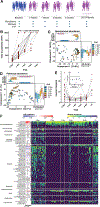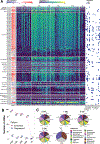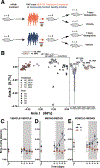Commensal antimicrobial resistance mediates microbiome resilience to antibiotic disruption
- PMID: 38232140
- PMCID: PMC11017772
- DOI: 10.1126/scitranslmed.adi9711
Commensal antimicrobial resistance mediates microbiome resilience to antibiotic disruption
Abstract
Despite their therapeutic benefits, antibiotics exert collateral damage on the microbiome and promote antimicrobial resistance. However, the mechanisms governing microbiome recovery from antibiotics are poorly understood. Treatment of Mycobacterium tuberculosis, the world's most common infection, represents the longest antimicrobial exposure in humans. Here, we investigate gut microbiome dynamics over 20 months of multidrug-resistant tuberculosis (TB) and 6 months of drug-sensitive TB treatment in humans. We find that gut microbiome dynamics and TB clearance are shared predictive cofactors of the resolution of TB-driven inflammation. The initial severe taxonomic and functional microbiome disruption, pathobiont domination, and enhancement of antibiotic resistance that initially accompanied long-term antibiotics were countered by later recovery of commensals. This resilience was driven by the competing evolution of antimicrobial resistance mutations in pathobionts and commensals, with commensal strains with resistance mutations reestablishing dominance. Fecal-microbiota transplantation of the antibiotic-resistant commensal microbiome in mice recapitulated resistance to further antibiotic disruption. These findings demonstrate that antimicrobial resistance mutations in commensals can have paradoxically beneficial effects by promoting microbiome resilience to antimicrobials and identify microbiome dynamics as a predictor of disease resolution in antibiotic therapy of a chronic infection.
Figures






References
-
- Reyman M, van Houten MA, Watson RL, Chu MLJN, Arp K, de Waal WJ, Schiering I, Plötz FB, Willems RJL, van Schaik W, Sanders EAM, Bogaert D. Effects of early-life antibiotics on the developing infant gut microbiome and resistome: a randomized trial. Nature Communications. 2022;13(1):893. doi: 10.1038/s41467-022-28525-z. - DOI - PMC - PubMed
Publication types
MeSH terms
Substances
Grants and funding
LinkOut - more resources
Full Text Sources

